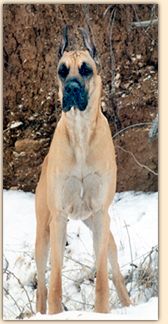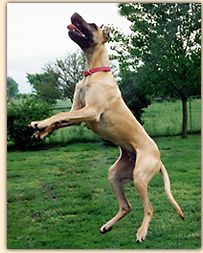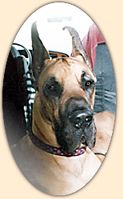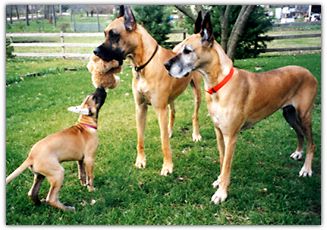|
– DCM is Not
a 4-Letter Word –
July 15, 2002 – This is the fourth
installment in our series on dilated cardiomyopathy (DCM) in the
Great Dane. Installment #1 introduced
you to the topic with the story of Phlash, a fawn who was lost to
DCM at the age of five. Installment #2
presented a harlequin named Harley, another DCM fatality. We also
covered basic information about dilated cardiomyopathy in the Great
Dane and discussed diagnosis, treatment and possible causes. Installment
#3 asked the burning question, "Is DCM an inherited disease?"
We took a look at some preliminary pedigree research which strongly
suggests dilated cardiomyopathy is passed from parent to offspring
via an X-linked recessive gene. We then explored the implications.

This week we'll hear from a breeder who was shocked to discover
DCM in her line. What did she do about it? What advice does she
offer? This is her story:

|


By Joanne Blair
 Hank
was born and died in my house, with me by his side.
His mother was my first show quality
Great Dane and Hank was out of my first litter. He developed
into a handsome boy, reaching 170 pounds and 37" at maturity.
Finishing his championship title at 18 months, he went on to
earn approximately 20 Best of Breeds and 10 group placements
– all these accomplishments with me at the end of the lead,
which makes Hank’s success all the more remarkable! He
also earned a TD (Tracking Dog) title. Hank was a fine, healthy,
athletic dog. He adored swimming, taking long walks and running
in the pastures with his other dog buddies. He was also my best
friend; when we were together he never let me out of his sight.
There was something eerie about Hank – he would often just
stare at me as if he was looking into my head or something. Hank
was born and died in my house, with me by his side.
His mother was my first show quality
Great Dane and Hank was out of my first litter. He developed
into a handsome boy, reaching 170 pounds and 37" at maturity.
Finishing his championship title at 18 months, he went on to
earn approximately 20 Best of Breeds and 10 group placements
– all these accomplishments with me at the end of the lead,
which makes Hank’s success all the more remarkable! He
also earned a TD (Tracking Dog) title. Hank was a fine, healthy,
athletic dog. He adored swimming, taking long walks and running
in the pastures with his other dog buddies. He was also my best
friend; when we were together he never let me out of his sight.
There was something eerie about Hank – he would often just
stare at me as if he was looking into my head or something.

In May 1998, when Hank was 3.5 years old, we were in the group
ring at a show in Iowa. I noticed that Hank was not his usual
exuberant self. He wasn’t very interested in the bait and
he just stood there. Usually, he would stand tall and alert.
He loved to move out with the other dogs. This day he was different.
I attributed his lackluster attitude to the long drive to the
show site and the high humidity. Back home Hank seemed more
himself. Two weeks later, though, I heard him in the other room,
making a sound like he was trying to retch. I thought, "Oh
no, Hank has kennel cough again!" That’s exactly what
this gagging sound reminded me of – kennel cough.

Dilated Cardiomyopathy (DCM)

 That
night, I could not sleep. It seems I knew something was seriously
wrong with Hank. I recall sitting up in bed with the realization
that Hank had cardiomyopathy. I’m not sure how I knew this.
I had never even seen another dog with DCM, but I knew that’s
what he had. That
night, I could not sleep. It seems I knew something was seriously
wrong with Hank. I recall sitting up in bed with the realization
that Hank had cardiomyopathy. I’m not sure how I knew this.
I had never even seen another dog with DCM, but I knew that’s
what he had.

The very next day we were at Kansas State University Veterinary
Teaching Hospital and I heard what I already knew – dilated
cardiomyopathy, with atrial fibrillation and pulmonary edema.
Hank’s disease was already in the severe stage. He was
diagnosed by physical examination, blood tests, x-ray (which
showed a grossly enlarged heart), cardiac ultrasound and electrocardiograph.
Hank was immediately admitted to the ICU for supplemental oxygen,
IV Lasix, and 24-hour monitoring. He was started on oral Digoxin
and Lisinopril.

After his edema was under control, Hank came home with a bucket
of pills, home care instructions a mile long, and the stern
warning that exercise could lead to a heart attack at any moment.
I told my vet that despite the warnings, I would not restrict
my outdoor-loving dog’s activity in the least. If Hank
had a sudden heart attack and died while running his pasture,
then that would be preferable to wasting away on the couch.
She agreed with my decision. It was the right one – for
Hank.

Coping with the news

While dealing with the shock that my beloved dog was soon
going to die, learning to give the right medications at
the right time, while keeping his weight up and paying
the approximately $250 in medical bills per month, I also
had to consider the genetic implications of this disease
on my budding "line." Obviously, I would not
allow Hank to be bred further.

I had the unfortunate task of calling up the owners of
several bitches who were to be bred to Hank, and telling
them he was no longer available – and why. I also
had the gut-wrenching chore of contacting the six people
who owned littermates of Hank and the six people who had
sons and daughters of Hank, to inform them their puppies
were at increased risk for DCM. At that time, not much
was known about the inheritance of DCM in Great Danes.
The KSU vets could only tell me that Hank’s offspring
were at increased risk and should be thoroughly examined
for early symptoms, at least once a year. |

Maintaining the patient

During the remaining 9 months of Hank’s illness, we tried
a few experimental "treatments" to improve his qualify
of life. I believe they paid off, but they certainly aren’t
proven. We used supplements such as Coenzyme Q-10 in fairly
high doses (1 mg per pound body weight, 2 times per day), milk
thistle to help with liver function (cardio meds may cause problems
with the liver), dandelion root as a natural diuretic, Vitamin
E, B-complex, and Ester C. Hank also received acupuncture treatments
to help with the atrial fibrillation. The acupuncture-certified
veterinarian who treated Hank said that while acupuncture is
not indicated for DCM, it might prove helpful with the irregular
heartbeats.

 The
cumulative effects of the appetite-suppressing drugs, increased
respiration and edema caused Hank’s appetite to take a
dive. We "tweaked" his meds, which helped. He had
not lost appreciable weight, in fact, Hank never looked very
thin, but I wanted to keep it that way . It is important that
DCM dogs eat – their bodies need more calories than healthy
dogs. Because intact males commonly stop eating when around
bitches in season, I wanted Hank neutered before his young daughter
came in season. Our KSU vet said, "No way, it’s too
risky." Our acupuncture vet, who had performed C-sections
using nothing for anesthesia but acupuncture needles, suggested
we contact a vet at Colorado State University who was a board-certified
cardiologist AND was certified in acupuncture. After reviewing
Hank’s records, the CSU vet said he could do it using minimal
sedation and acupuncture needles for anesthesia and pain control.
So off to CSU we went. Hank was neutered and he recovered fully.
When his daughter came into season a couple of months later,
he could have cared less. The
cumulative effects of the appetite-suppressing drugs, increased
respiration and edema caused Hank’s appetite to take a
dive. We "tweaked" his meds, which helped. He had
not lost appreciable weight, in fact, Hank never looked very
thin, but I wanted to keep it that way . It is important that
DCM dogs eat – their bodies need more calories than healthy
dogs. Because intact males commonly stop eating when around
bitches in season, I wanted Hank neutered before his young daughter
came in season. Our KSU vet said, "No way, it’s too
risky." Our acupuncture vet, who had performed C-sections
using nothing for anesthesia but acupuncture needles, suggested
we contact a vet at Colorado State University who was a board-certified
cardiologist AND was certified in acupuncture. After reviewing
Hank’s records, the CSU vet said he could do it using minimal
sedation and acupuncture needles for anesthesia and pain control.
So off to CSU we went. Hank was neutered and he recovered fully.
When his daughter came into season a couple of months later,
he could have cared less.

We had our share of crises in those 9 months. The edema would
build up and Hank’s breathing would be labored and he would
start gagging. We’d rush to the hospital where his meds
would be adjusted, his liver function checked, and his DCM evaluated.
Hank was worsening, but slowly. The vet staff was impressed
with Hank’s condition and attitude. When I told them it
was due to all the running he did in the pasture, their faces
paled.

DCM is not a 4-letter word

Hank continued to go to shows with us when I exhibited
his daughter. I would walk him around the show site and
people would ask why he wasn’t being shown. When
I told them about his DCM, most people would become silent.
I knew I was breaking the "code of silence"
but frankly, that didn’t matter a bit to me. I felt
it was important to be open, honest and not to feel guilty
because I owned and had bred a "faulty" dog.
I did not take the DCM personally; no one tries or wants
to breed an animal that is going to die prematurely from
an inherited disease. And I certainly was not going to
hide Hank away. So we went to shows, even to the GDCA
National. |

Time to say good-bye

Eventually, the fluid buildup, decreased pumping ability of
his heart, and the side effects of all the drugs caught up with
Hank. On his last night, he attempted to get off my bed. Instead,
he collapsed on the floor. He just lay there on his stomach,
taking rapid, shallow breaths. I petted him and kissed his handsome
face. I knew this was it. It was midnight and I couldn’t
bring myself to wake my vet, ask her to drive out to my rural
house and euthanize Hank. So I lay on the floor with him until
dawn. During the night he had several bouts of black, smelly
diarrhea – a symptom of liver damage I was later told.
I cried until my eyes nearly swelled shut. Hank was only 4 years
old. He had lived 9 months since initial diagnosis; 6 months
beyond the vet’s prediction. And now he was dying right
before my eyes. He had such a good quality of life up until
that night. I guess I ought to be more thankful for that. My
vet came at 7:30 the next morning. I held Hank’s huge head
while she freed him from his torment.


Advice
to other breeders...

I told Ginnie that I was over this, as it has been
a good 3 years since Hank’s death. After writing
this piece, I guess that was lie; I don’t think
I am over this and likely never will be. I don’t
think any of us who have experienced this horrific
disease will ever "get over it" totally.
So what do we do? How do we justify the short lives
of our devoted companions, our show dogs, and our
breeding stock? How? By helping to support research
into finding a genetic marker for DCM in Great Danes.
I don’t see any other fix for this problem due
to the recessive nature of its inheritance. As discussed
in last week's DaDane,
current preliminary research shows that DCM in Great
Danes follows an X-linked recessive inheritance. Under
this theory, affected males bred to normal females
produce 100% carrier females and 100% normal males.
When these carrier females are bred, the cycle begins
all over again, producing more DCM males and more
carrier females.

What can breeders do until a genetic marker is available?
- Study pedigrees carefully.
If you own a bitch and are looking for a male to breed
to, ask how old the male’s parents and grandparents
were when they died, and what they died of. If the
male’s owner does not know, find out! Look carefully
at the male’s maternal grandsire. How old was
he when he died? If he died at age 2 from gastric
torsion, you cannot rule out cardio, as many cases
of DCM are asymptomatic until the dog is older.

- Breed to older males.
This may require stud dog owners to take advantage
of semen freezing. Having a male who is alive and
producing viable semen at 10 years is likely unusual,
so having frozen semen available allows us to use
dogs who have lived to a ripe old age.

- Screen
your dog before breeding. If you own a stud dog,
have him DCM-cleared immediately prior to a breeding;
if you are a bitch owner, insist that any male you
breed to is cleared prior to breeding. Don’t
breed to that dog if the owner refuses. With this
said, do NOT place total blind faith on a cleared
dog.

- Be open and honest regarding
your own dogs’ history. Don’t start
or perpetuate rumors, but be willing to tell those
involved when you have a dog diagnosed with DCM. This
is especially important for people who have puppies
out of your dog or who have bred females to your dog.
|
— By Joanne Blair
|
Closing comments
I want to thank Joanne Blair for coming forward to tell her DCM story
from a breeder's perspective. DCM is a terminal disease – almost
certainly inherited – and there's plenty of it out there.
Countless Great Danes, along with their owners, have experienced the
anguish of DCM. Many more will do so. This trail of death will continue
from generation to generation unless the shroud of silence that surrounds
DCM is lifted. Make no mistake about it, if you are breeding "cardio,"
you are breeding broken hearts. And it doesn't have to be that way.

Thanks to the ongoing research by Dr.
Kate Meurs at OSU, the Great Dane community has been given the
remarkable opportunity to do something about DCM – besides
just whispering behind closed doors. Let's not blow it. If you have
owned or bred a DCM dog, please make your dog's medical report and
pedigree available to Dr. Meurs for further study. Your information
and your identity will be held in the strictest confidence.

Copies of pedigrees and medical reports (for verification of DCM diagnosis)
should be sent to:
 Dr. Kate M. Meurs Dr. Kate M. Meurs
 Ohio State University,
College of Veterinary Medicine Ohio State University,
College of Veterinary Medicine
 Dept. of Veterinary Clinical
Sciences, Cardiology Dept. of Veterinary Clinical
Sciences, Cardiology
 601 Vernon L. Tharp Street 601 Vernon L. Tharp Street
 Columbus, Ohio 43210-1089. Columbus, Ohio 43210-1089.
 Email: meurs.1@osu.edu Email: meurs.1@osu.edu

Please support this effort. You can say
"no" to cardio, simply by saying "yes" to research.
—
©2002 by Ginnie
Saunders
Installment
#1 || Installment
#2 || Installment #3
©2002-2008
by Ginnie Saunders. All rights are reserved. No part of this web
site
may be reproduced or transmitted in any form or by any means —
electronic or mechanical, including photocopying, recording, or by
any information storage or retrieval system — without written
permission from Ginnie
Saunders. To learn more about copyright issues on the web,
visit the Web Law
FAQ.
Ginnie.com, Inc.
PO Box 50314
Columbia, SC 29250
(803) 783-3169
www.ginnie.com
|


|

![]()




 That
night, I could not sleep. It seems I knew something was seriously
wrong with Hank. I recall sitting up in bed with the realization
that Hank had cardiomyopathy. I’m not sure how I knew this.
I had never even seen another dog with DCM, but I knew that’s
what he had.
That
night, I could not sleep. It seems I knew something was seriously
wrong with Hank. I recall sitting up in bed with the realization
that Hank had cardiomyopathy. I’m not sure how I knew this.
I had never even seen another dog with DCM, but I knew that’s
what he had. The
cumulative effects of the appetite-suppressing drugs, increased
respiration and edema caused Hank’s appetite to take a
dive. We "tweaked" his meds, which helped. He had
not lost appreciable weight, in fact, Hank never looked very
thin, but I wanted to keep it that way . It is important that
DCM dogs eat – their bodies need more calories than healthy
dogs. Because intact males commonly stop eating when around
bitches in season, I wanted Hank neutered before his young daughter
came in season. Our KSU vet said, "No way, it’s too
risky." Our acupuncture vet, who had performed C-sections
using nothing for anesthesia but acupuncture needles, suggested
we contact a vet at Colorado State University who was a board-certified
cardiologist AND was certified in acupuncture. After reviewing
Hank’s records, the CSU vet said he could do it using minimal
sedation and acupuncture needles for anesthesia and pain control.
So off to CSU we went. Hank was neutered and he recovered fully.
When his daughter came into season a couple of months later,
he could have cared less.
The
cumulative effects of the appetite-suppressing drugs, increased
respiration and edema caused Hank’s appetite to take a
dive. We "tweaked" his meds, which helped. He had
not lost appreciable weight, in fact, Hank never looked very
thin, but I wanted to keep it that way . It is important that
DCM dogs eat – their bodies need more calories than healthy
dogs. Because intact males commonly stop eating when around
bitches in season, I wanted Hank neutered before his young daughter
came in season. Our KSU vet said, "No way, it’s too
risky." Our acupuncture vet, who had performed C-sections
using nothing for anesthesia but acupuncture needles, suggested
we contact a vet at Colorado State University who was a board-certified
cardiologist AND was certified in acupuncture. After reviewing
Hank’s records, the CSU vet said he could do it using minimal
sedation and acupuncture needles for anesthesia and pain control.
So off to CSU we went. Hank was neutered and he recovered fully.
When his daughter came into season a couple of months later,
he could have cared less.
